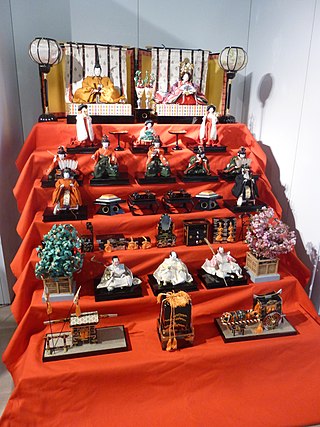
Hinamatsuri, also called Doll's Day or Girls' Day, is a religious (Shinto) holiday in Japan, celebrated on 3 March of each year. Platforms covered with a red carpet–material are used to display a set of ornamental dolls representing the Emperor, Empress, attendants, and musicians in traditional court dress of the Heian period.

Fuchū is a city located in Hiroshima Prefecture, Japan. As of 1 April 2023, the city had an estimated population of 36,326 in 17013 households and a population density of 190 persons per km2. The total area of the city is 195.75 square kilometres (75.58 sq mi).

A pantry is a room or cupboard where beverages, food, (sometimes) dishes, household cleaning products, linens or provisions are stored within a home or office. Food and beverage pantries serve in an ancillary capacity to the kitchen.

A nightstand, alternatively night table, bedside table, daystand or bedside cabinet, is a small table or cabinet designed to stand beside a bed or elsewhere in a bedroom. Modern nightstands are usually small bedside tables, often with one or sometimes more drawers and/or shelves and less commonly with a small door. They are often used to support items that might be useful during the night, such as a table lamp, reading matter, cell phone, eyeglasses, tissues, a drink, or medication.
The Japanese kitchen is the place where food is prepared in a Japanese house. Until the Meiji era, a kitchen was also called kamado and there are many sayings in the Japanese language that involve kamado as it was considered the symbol of a house. The term could even be used to mean "family" or "household". Separating a family was called kamado wo wakeru, or "divide the stove". Kamado wo yaburu means that the family was broken.
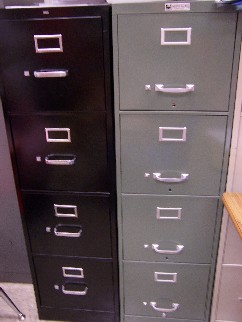
A filing cabinet is an item of office furniture for storing paper documents in file folders. In the most simple context, it is an enclosure for drawers in which articles are stored. The two most common forms of filing cabinets are vertical files and lateral files. A vertical file cabinet has drawers that extend from the short side of the cabinet. A lateral file cabinet has drawers that extend from the long side of the cabinet. These are also called side filers in Great Britain. There are also shelf files which go on shelves. In the United States, file cabinets are usually built to accommodate 8.5 × 11 paper, and in other countries, filing cabinets are often designed to hold other sizes of paper, such as A4 paper.

A chest is a form of furniture typically of a rectangular structure with four walls and a removable or hinged lid, used for storage, usually of personal items. The interior space may be subdivided.

A chest of drawers, also called a dresser or a bureau, is a type of cabinet that has multiple parallel, horizontal drawers generally stacked one above another.

A cupboard is a piece of furniture for enclosing dishware or grocery items that are stored in a home. The term is sometimes also used for any form of cabinet or enclosed bookcase. It gradually evolved from its original meaning: an open-shelved side table for displaying dishware, more specifically plates, cups and saucers.
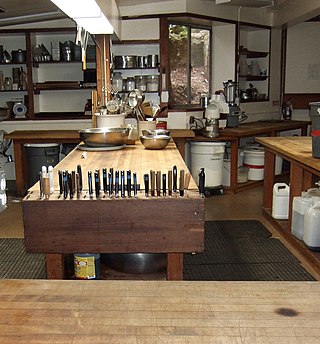
Kitchen cabinets are the built-in furniture installed in many kitchens for storage of food, cooking equipment, and often silverware and dishes for table service. Appliances such as refrigerators, dishwashers, and ovens are often integrated into kitchen cabinetry. There are many options for cabinets available at present.

Raden (螺鈿) is a Japanese term for one of the decorative techniques used in traditional crafts and woodwork. It refers to a method of inserting nacre into a carved surface of lacquer or wood. The kanji for ra (螺) means 'shell' and den (鈿) means 'inlaid'. Raden is a term used only for the technique or work of inlaying thin layers of pearl shells. In Japan, the technique of embedding the mother of pearl of shellfish in lacquer is called raden, while the technique of embedding metal or ivory is called zōgan (象嵌).
Traditionalcrafts in Japan have a long tradition and history. Included in the category of traditional crafts are handicrafts produced by an individual or a group, as well as work produced by independent studio artists working with traditional craft materials and/or processes.
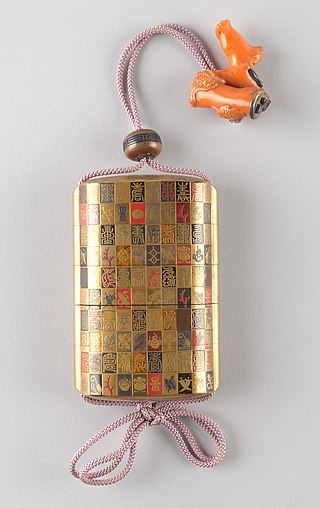
An inro is a traditional Japanese case for holding small objects, suspended from the obi (sash) worn around the waist when wearing a kimono. They are often highly decorated with various materials such as lacquer and various techniques such as maki-e, and are more decorative than other Japanese lacquerware.

A drawer is a box-shaped container inside a piece of furniture that can be pulled out horizontally to access its contents. Drawers are built into numerous types of furniture, including cabinets, chests of drawers (bureaus), desks, and the like.
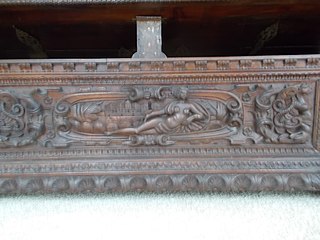
A hope chest, also called dowry chest, cedar chest, trousseau chest, or glory box, is a piece of furniture once commonly used by unmarried young women to collect items, such as clothing and household linen, in anticipation of married life.

Lacquerware is a Japanese craft with a wide range of fine and decorative arts, as lacquer has been used in urushi-e, prints, and on a wide variety of objects from Buddha statues to bento boxes for food.
A wardrobe, also called armoire or almirah, is a standing closet used for storing clothes. The earliest wardrobe was a chest, and it was not until some degree of luxury was attained in regal palaces and the castles of powerful nobles that separate accommodation was provided for the apparel of the great. The name of wardrobe was then given to a room in which the wall-space was filled with closets and lockers, the drawer being a comparatively modern invention. From these cupboards and lockers the modern wardrobe, with its hanging spaces, sliding shelves and drawers, evolved slowly.

A cabinet is a case or cupboard with shelves or drawers for storing or displaying items. Some cabinets are stand alone while others are built in to a wall or are attached to it like a medicine cabinet. Cabinets are typically made of wood, coated steel, or synthetic materials. Commercial grade cabinets usually have a melamine-particleboard substrate and are covered in a high-pressure decorative laminate, commonly referred to as Wilsonart or Formica.

What later came to be known as the William and Mary style is a furniture design common from 1700 to 1725 in the Netherlands, Kingdom of England, Kingdom of Scotland and Kingdom of Ireland, and later in England's American colonies. It was a transitional style between Mannerist furniture and Queen Anne furniture. Sturdy, emphasizing both straight lines and curves, and featuring elaborate carving and woodturning, the style was one of the first to imitate Asian design elements such as japanning.

























